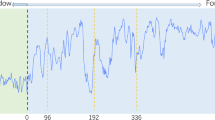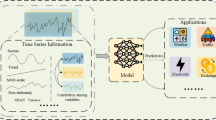Abstract
Deep learning models have been widely applied in the field of long-term forecasting has achieved significant success, with the incorporation of inductive bias such as periodicity to model multi-granularity representations of time series being a commonly employed design approach in forecasting methods. However, existing methods still face challenges related to information redundancy during the extraction of inductive bias and the learning process for multi-granularity features. The presence of redundant information can impede the acquisition of a comprehensive temporal representation by the model, thereby adversely impacting its predictive performance. To address the aforementioned issues, we propose a De-Redundant Multi-Period Hybrid Modeling Network (DPHM-Net) that effectively eliminates redundant information from the series inductive bias extraction mechanism and the multi-granularity series features in the time series representation learning. In DPHM-Net, we propose an efficient time series representation learning process based on a period inductive bias and introduce the concept of de-redundancy among multiple time series into the representation learning process for single time series. Additionally, we design a specialized gated unit to dynamically balance the elimination weights between series features and redundant semantic information. The advanced performance and high efficiency of our method in long-term forecasting tasks against previous state-of-the-art are demonstrated through extensive experiments on real-world datasets.








Similar content being viewed by others
Availability of data and materials
References
Song, H., Rajan, D., Thiagarajan, J., Spanias, A.: Attend and diagnose: Clinical time series analysis using attention models. In: Proceedings of the AAAI Conference on Artificial Intelligence, vol. 32 (2018)
Patton, A.: Copula methods for forecasting multivariate time series. Handbook of economic forecasting 2, 899–960 (2013)
Angryk, R.A., Martens, P.C., Aydin, B., Kempton, D., Mahajan, S.S., Basodi, S., Ahmadzadeh, A., Cai, X., Filali Boubrahimi, S., Hamdi, S.M., et al.: Multivariate time series dataset for space weather data analytics. Scientific data 7(1), 227 (2020)
Demirel, Ö.F., Zaim, S., Çalişkan, A., Özuyar, P Forecasting natural gas consumption in istanbul using neural networks and multivariate time series methods. Turkish J. Electr. Eng. Comput. Sci. 20(5), 695–711 (2012)
Wang, H., Peng, J., Huang, F., Wang, J., Chen, J., Xiao, Y.: Micn: Multi-scale local and global context modeling for long-term series forecasting. In: The Eleventh International Conference on Learning Representations (2022)
Zhang, Y., Yan, J.: Crossformer: Transformer utilizing cross-dimension dependency for multivariate time series forecasting. In: The Eleventh International Conference on Learning Representations (2022)
Nie, Y., Nguyen, N.H., Sinthong, P., Kalagnanam, J.: A time series is worth 64 words: Long-term forecasting with transformers. arXiv preprint arXiv:2211.14730 (2022)
Zhou, T., Ma, Z., Wen, Q., Wang, X., Sun, L., Jin, R.: Fedformer: Frequency enhanced decomposed transformer for long-term series forecasting. In: International Conference on Machine Learning, pp. 27268–27286 (2022). PMLR
Wu, H., Xu, J., Wang, J., Long, M.: Autoformer: Decomposition transformers with auto-correlation for long-term series forecasting. Adv. Neural. Inf. Process. Syst. 34, 22419–22430 (2021)
Wu, H., Hu, T., Liu, Y., Zhou, H., Wang, J., Long, M.: Timesnet: Temporal 2d-variation modeling for general time series analysis. arXiv preprint arXiv:2210.02186 (2022)
Borovykh, A., Bohte, S., Oosterlee, C.W.: Conditional time series forecasting with convolutional neural networks. arXiv preprint arXiv:1703.04691 (2017)
Szegedy, C., Liu, W., Jia, Y., Sermanet, P., Reed, S., Anguelov, D., Erhan, D., Vanhoucke, V., Rabinovich, A.: Going deeper with convolutions. In: Proceedings of the IEEE Conference on Computer Vision and Pattern Recognition, pp. 1–9 (2015)
Sen, R., Yu, H.-F., Dhillon, I.S.: Think globally, act locally: A deep neural network approach to high-dimensional time series forecasting. Advances in neural information processing systems 32 (2019)
Vaswani, A., Shazeer, N., Parmar, N., Uszkoreit, J., Jones, L., Gomez, A.N., Kaiser, Ł., Polosukhin, I.: Attention is all you need. Advances in neural information processing systems 30 (2017)
Tenney, I., Das, D., Pavlick, E.: Bert rediscovers the classical nlp pipeline. arXiv preprint arXiv:1905.05950 (2019)
Kang, W.-C., McAuley, J.: Self-attentive sequential recommendation. In: 2018 IEEE International Conference on Data Mining (ICDM), pp. 197–206 (2018). IEEE
Dosovitskiy, A., Beyer, L., Kolesnikov, A., Weissenborn, D., Zhai, X., Unterthiner, T., Dehghani, M., Minderer, M., Heigold, G., Gelly, S., et al.: An image is worth 16x16 words: Transformers for image recognition at scale. arXiv preprint arXiv:2010.11929 (2020)
Zhou, H., Zhang, S., Peng, J., Zhang, S., Li, J., Xiong, H., Zhang, W.: Informer: Beyond efficient transformer for long sequence time-series forecasting. In: Proceedings of the AAAI Conference on Artificial Intelligence, vol. 35, pp. 11106–11115 (2021)
Kitaev, N., Kaiser, Ł., Levskaya, A.: Reformer: The efficient transformer. arXiv preprint arXiv:2001.04451 (2020)
Woo, G., Liu, C., Sahoo, D., Kumar, A., Hoi, S.: Etsformer: Exponential smoothing transformers for time-series forecasting. arXiv preprint arXiv:2202.01381 (2022)
Zeng, A., Chen, M., Zhang, L., Xu, Q.: Are transformers effective for time series forecasting? In: Proceedings of the AAAI Conference on Artificial Intelligence, vol. 37, pp. 11121–11128 (2023)
Gardner, E.S., Jr.: Exponential smoothing: The state of the art. J. Forecast. 4(1), 1–28 (1985)
Gardner, E.S., Jr.: Exponential smoothing: The state of the —part ii. Int. J. Forecast. 22(4), 637–666 (2006)
Bartholomew, D.J.: Time Series Analysis Forecasting and Control. JSTOR (1971)
Box, G., Jenkins, G., Reinsel, G., Ljung, G.: Time Series Analysis: Forecasting and Control. John Willey and Sons, New Jersey (2016)
Hoerl, A.E., Kennard, R.W.: Ridge regression: Biased estimation for nonorthogonal problems. Technometrics 12(1), 55–67 (1970)
Vapnik, V., Golowich, S., Smola, A.: Support vector method for function approximation, regression estimation and signal processing. Advances in neural information processing systems 9 (1996)
Roberts, S., Osborne, M., Ebden, M., Reece, S., Gibson, N., Aigrain, S.: Gaussian processes for time-series modelling. Philosophical Transactions of the Royal Society A: Mathematical, Physical and Engineering Sciences 371(1984), 20110550 (2013)
Cleveland, R.B., Cleveland, W.S., McRae, J.E., Terpenning, I.: Stl: A seasonal-trend decomposition. J. Off. Stat 6(1), 3–73 (1990)
Bloomfield, P.: Fourier Analysis of Time Series: an Introduction. John Wiley & Sons, (2004)
Chung, J., Gulcehre, C., Cho, K., Bengio, Y.: Empirical evaluation of gated recurrent neural networks on sequence modeling. arXiv preprint arXiv:1412.3555 (2014)
Hochreiter, S., Schmidhuber, J.: Long short-term memory. Neural Comput. 9(8), 1735–1780 (1997)
Lai, G., Chang, W.-C., Yang, Y., Liu, H.: Modeling long-and short-term temporal patterns with deep neural networks. In: The 41st International ACM SIGIR Conference on Research & Development in Information Retrieval, pp. 95–104 (2018)
Temporal pattern attention for multivariate time series forecasting: Shih, S.-Y., Sun, F.-K., Lee, H.-y. Mach. Learn. 108, 1421–1441 (2019)
Ullah, S., Xu, Z., Wang, H., Menzel, S., Sendhoff, B., Bäck, T.: Exploring clinical time series forecasting with meta-features in variational recurrent models. In: 2020 International Joint Conference on Neural Networks (IJCNN), pp. 1–9 (2020). IEEE
Liu, Y., Wu, H., Wang, J., Long, M.: Non-stationary transformers: Rethinking the stationarity in time series forecasting. arXiv preprint arXiv:2205.14415 (2022)
Oreshkin, B.N., Carpov, D., Chapados, N., Bengio, Y.: N-beats: Neural basis expansion analysis for interpretable time series forecasting. arXiv preprint arXiv:1905.10437 (2019)
Challu, C., Olivares, K.G., Oreshkin, B.N., Ramirez, F.G., Canseco, M.M., Dubrawski, A.: Nhits: Neural hierarchical interpolation for time series forecasting. In: Proceedings of the AAAI Conference on Artificial Intelligence, vol. 37, pp. 6989–6997 (2023)
Zhang, T., Zhang, Y., Cao, W., Bian, J., Yi, X., Zheng, S., Li, J.: Less is more: Fast multivariate time series forecasting with light sampling-oriented mlp structures. arXiv preprint arXiv:2207.01186 (2022)
Hou, M., Xu, C., Li, Z., Liu, Y., Liu, W., Chen, E., Bian, J.: Multi-granularity residual learning with confidence estimation for time series prediction. In: Proceedings of the ACM Web Conference 2022, pp. 112–121 (2022)
Johnson, A.E., Pollard, T.J., Shen, L., Lehman, L.-w.H., Feng, M., Ghassemi, M., Moody, B., Szolovits, P., Anthony Celi, L., Mark, R.G.: Mimic-iii, a freely accessible critical care database. Scientific data 3( 1), 1–9 (2016)
Harutyunyan, H., Khachatrian, H., Kale, D.C., Ver Steeg, G., Galstyan, A.: Multitask learning and benchmarking with clinical time series data. Scientific Data 6(1), 96 (2019). https://doi.org/10.1038/s41597-019-0103-9
Paszke, A., Gross, S., Massa, F., Lerer, A., Bradbury, J., Chanan, G., Killeen, T., Lin, Z., Gimelshein, N., Antiga, L., et al.: Pytorch: An imperative style, high-performance deep learning library. Advances in neural information processing systems 32 (2019)
Kingma, D.P., Ba, J.: Adam: A method for stochastic optimization. arXiv preprint arXiv:1412.6980 (2014)
Funding
This work is supported by the National Natural Science Foundation of China (Grant No.62376135).
Author information
Authors and Affiliations
Contributions
Zheng conducted the creation of model, performed the data curation and analysis, and wrote the manuscript. All authors reviewed the manuscript.
Corresponding author
Ethics declarations
Competing interests
The authors declare no competing interests.
Additional information
Publisher's Note
Springer Nature remains neutral with regard to jurisdictional claims in published maps and institutional affiliations.
Appendices
Appendix A: Details of experiments
1.1 A. 1 Evalution metrics
We use the metrics commonly used in prediction tasks, i.e., mean square error(MSE) and mean absolute error(MAE), as performance evaluation metrics, which are defined as follows:
where n is the number of samples, \(y_{i}\) is the ground truth and \(\hat{y}_{i}\) is the prediction result.
1.2 A.2 Dataset statistics and hyperparameters
All the experimental Settings are the same as in TimesNet [10]. Table 9 lists detailed information about all the datasets used in the experiments of this paper and the hyperparameter settings for our paper’s method on all datasets, where MIMIC-III is the decompensation task data [42] extracted from the patient No.58242 in the database, \(d_{model}\), \(d_{ff}\), \(e_{layers}\) denotes the dimension of embedding, the demension of hidden representation, the number of encoder layers respectively. The seed is set to 2021.
1.3 A.3 Algorithm of multi-period extraction
TimesNet’s multi-period extraction algorithm and DPHM-Net’s multi-period extraction algorithm are presented as follows:
In Algorithm 3 and Algorithm 4, x denotes the input series and k denotes the number of periods to be extracted, returning the extracted period lengths and their corresponding amplitude values. Our improved algorithm guarantees the uniqueness of the extracted period lengths.
Appendix B: Showcases of main results
1.1 B.1 Multivariate time series forecasting
As shown in Figures 7, 8, 9, 10, 11, 12, 13 and 14, we plot the forecasting results from test set of multivariate datasets ETTm1 and ETTm2. The results show that the prediction results of our methods are more closely aligned with the trend of the ground truth. Moreover, DPHM-Net and DPHM(G)-Net are better at predicting more detailed localized changes.
1.2 B.2 Univariate time series Forecasting
As shown in Figures 15, 16, 17 and 18, we plot the forecasting result from the test set of univariate dataset Electricity. The results show that our method has better prediction accuracy and can predict random changes in the data with sudden upswings or downswings.
Rights and permissions
Springer Nature or its licensor (e.g. a society or other partner) holds exclusive rights to this article under a publishing agreement with the author(s) or other rightsholder(s); author self-archiving of the accepted manuscript version of this article is solely governed by the terms of such publishing agreement and applicable law.
About this article
Cite this article
Zheng, C., Shi, Y., Lee, W. et al. DPHM-Net:de-redundant multi-period hybrid modeling network for long-term series forecasting. World Wide Web 27, 40 (2024). https://doi.org/10.1007/s11280-024-01281-4
Received:
Revised:
Accepted:
Published:
DOI: https://doi.org/10.1007/s11280-024-01281-4


















